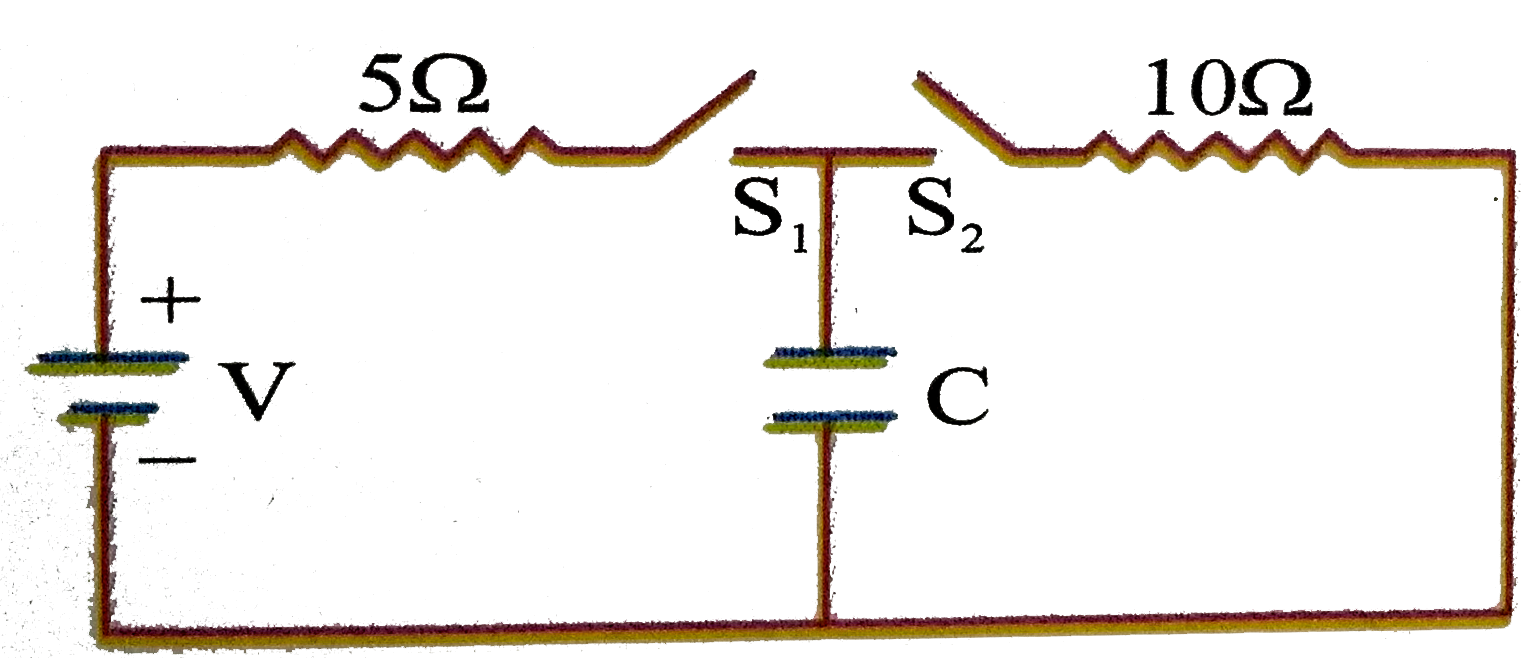A 2μF condenser is charged upto 200 V and then battery is removed. On combining this with another uncharged condenser in parallel, the potential differences between two plates are found to be 40 V. The capacity of second condenser is
2μF
4μF
8μF
16μF
The correct Answer is:C
To solve the problem step by step, we will follow the principles of capacitors and charge conservation.
Step 1: Calculate the charge on the first capacitor
The first capacitor has a capacitance of C1=2μF and is charged to a voltage of V1=200V.
Using the formula for charge Q=C×V:
Q1=C1×V1=2μF×200V=400μC
Step 2: Understand the configuration after combining capacitors
After disconnecting the battery, the charged capacitor is combined in parallel with an uncharged capacitor. The total charge remains the same, and the potential difference across both capacitors is now Vf=40V.
Step 3: Write the equation for charge conservation
The total charge before combining the capacitors must equal the total charge after combining them.
Let C2 be the capacitance of the second capacitor (the uncharged one). The charge on the first capacitor remains Q1=400μC, and the charge on the second capacitor when the voltage across it is 40V is given by:
Q2=C2×Vf=C2×40V
By conservation of charge:
Q1=Q2+Q3
Where Q3 is the charge on the first capacitor after they are connected:
400μC=2μF×40V+C2×40V
Step 4: Substitute and simplify
Calculate the charge on the first capacitor after combining:
Q3=2μF×40V=80μC
Now substitute this into the charge conservation equation:
400μC=80μC+C2×40V
Step 5: Solve for C2
Rearranging the equation gives:
400μC−80μC=C2×40V
320μC=C2×40V
C2=320μC40V=8μF
Final Answer
The capacitance of the second capacitor is C2=8μF.
---
The first capacitor has a capacitance of C1=2μF and is charged to a voltage of V1=200V.
Q1=C1×V1=2μF×200V=400μC
After disconnecting the battery, the charged capacitor is combined in parallel with an uncharged capacitor. The total charge remains the same, and the potential difference across both capacitors is now Vf=40V.
The total charge before combining the capacitors must equal the total charge after combining them.
Q2=C2×Vf=C2×40V
Q1=Q2+Q3
Where Q3 is the charge on the first capacitor after they are connected:
400μC=2μF×40V+C2×40V
Calculate the charge on the first capacitor after combining:
Q3=2μF×40V=80μC
400μC=80μC+C2×40V
Rearranging the equation gives:
400μC−80μC=C2×40V
320μC=C2×40V
C2=320μC40V=8μF
The capacitance of the second capacitor is C2=8μF.
Topper's Solved these Questions
- ELECTROSTATIC POTENTIAL AND CAPACITORSBOOK - DC PANDEY ENGLISHCHAPTER - ELECTROSTATIC POTENTIAL AND CAPACITORSEXERCISE - (B) Chapter exercises
17 Videos
- ELECTROSTATIC POTENTIAL AND CAPACITORSBOOK - DC PANDEY ENGLISHCHAPTER - ELECTROSTATIC POTENTIAL AND CAPACITORSEXERCISE - (C) Chapter exercises
50 Videos
- ELECTROSTATIC POTENTIAL AND CAPACITORSBOOK - DC PANDEY ENGLISHCHAPTER - ELECTROSTATIC POTENTIAL AND CAPACITORSEXERCISE - Check point 2.5
20 Videos
- ELECTROMAGNETIC WAVESBOOK - DC PANDEY ENGLISHCHAPTER - ELECTROMAGNETIC WAVESEXERCISE - Sec C
22 Videos
- ELECTROSTATICSBOOK - DC PANDEY ENGLISHCHAPTER - ELECTROSTATICSEXERCISE - Medical entrances gallery
37 Videos
Similar Questions
A 2μF condenser is charged upto 200 volt and then battery is removed. On combining this with another uncharged condenser in parallel, the potential difference is found to be 40 volt. Find the capacity of second condenser (in μF)
View Solution0.2F capacitor is charged to 600V by a battery. On removing the battery it is connected with another parallel plate condenser of 1F. The potential decreases to
View SolutionA 10μF capacitor is charged to a potential difference of 50V and is connected to another uncharged capacitor in parallel. Now the common potential difference becomes 20 volt. The capacitance of second capacitor is
View SolutionA 10μF capacitor is charged to a potential difference of 50V and is connected to another uncharged capacitor in parallel. Now the common potential difference becomes 20 volt. The capacitance of second capacitor is
View SolutionA condenser of capacitance 10μF has been charged to 100V. It is now connected to another uncharged condenser in parallel. The common potential becomes 40V. The capacitance of another condenser is
View SolutionIn the adjoining diagram, the condenser C will be fully charged to potential V if
 .
.
View SolutionA 100μF capacitor is charged to 100V. After the charging, battery is disconnected. The capacitor is then connected in parallel to another capacitor. The final voltage is 20V. Calculate the capacity of second capacitor.
View SolutionThree capacitors of 2μF,3μF and 6μF are joined in series and the combination is charged by means of a 24 volt battery. The potential difference between the plates of the 6μF capacitor is
View SolutionA and B are two points in a closed circuit. The potential difference across the condenser of capacity 5μF is

View SolutionIn a parallel plate capacitor of capacitor 1μF two plates are given charges 2μC and 4μC the potential difference between the plates of the capacitor is
_2019_CBT2_E01_002_Q01.png)
View Solution
